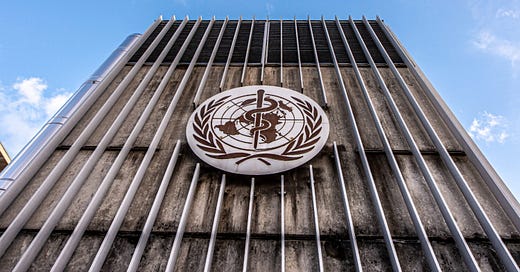How to reform the WHO despite Trump's withdrawal, exotic math for black holes, and other stories
Welcome to Ramin’s Space, the newsletter from science writer and editor Ramin Skibba. You can read more about the newsletter here. If you like it, please consider subscribing and sharing this post.
I’m heartened by some positive signs over the past couple weeks. First, Mohsen Mahdawi was released, and then Rümeysa Öztürk last week, and now Badar Khan Suri is set to be released today as well. The university students and scholars were effectively political prisoners, punished for expressing their views and exercising their free speech rights. I hope Mahmoud Khalil and many others will be freed soon as well. I’m also pleased that Palestinian poet Mosab Abu Toha won a Pulitzer for commentary. When he heard the news, he posted on X, “Let it bring hope / Let it be a tale.”
On May Day, hundreds of thousands of people joined protests in cities around the U.S. and around the world, in a show of strength supporting immigrant rights and labor solidarity. While this impressive turnout didn’t match the 1.5 million demonstrators during the historic May Day protests of 2006, it’s still a huge number, and just a few weeks after the wave of Hands Off protests, in addition to all the Tesla Takedown protests (which are arguably pushing Musk out of DOGE), Stand Up for Science protests, No Kings protests, Fighting Oligarchy rallies, and more.
I feel that a few U.S. political leaders are finally, belatedly, beginning to take note, and recent Canadian and Australian elections also demonstrated the scale of the international backlash against Trump and his allies’ harmful policies. In both of those countries, previously leading conservative parties were ultimately defeated in the ballot box. Trump himself suffers from low approval ratings, hovering at around 44%, the second lowest of any president at this point during their term—second only to the first Trump administration.
Health Experts Say: Don’t Abandon WHO, Reform It
Last time Trump tried to withdraw from the World Health Organization, it was reversed before it fully took effect. That won’t be the case this time, and the US’s exit from the organization was understandably condemned by global health advocates and was blasted by news media. Nevertheless, health experts have criticized the WHO in the past, and even one of Trump’s criticisms has some truth to it. The WHO should reform its bureaucracy, the scope of its mandate, and the way it responds to disease outbreaks and tries to advance health equity. The WHO also performs a unique and critical role for global health, and we’d all be worse off without it. The dozens of experts I spoke with for this Undark magazine piece have different perspectives, but they agree on one thing: The WHO should be reformed, not undermined. In this piece, as I often do, I tried to provide important context, beyond what you might have read in news headlines in January.
Deep Math from String Theory Appears in Clashing Black Holes
Now for something completely different: For Scientific American, I wrote a news story about physicists who discovered that obscure, abstract mathematical structures adopted from string theory actually have something to do with colossal black holes (or neutron stars, which are also massive and dense) when they hurtle past and deflect each other, releasing ripples in spacetime known as gravitational waves. Who knows, maybe in a few years astronomers will be able to detect signals of these invisible waves. This is a more technical article, but I think you nerdy readers will be into it.
In other writing…
Inside the controversial tree farms powering Apple’s carbon neutral goal, by Greg Barber in MIT Technology Review
Searches, a new book by Vauhini Vara, about selfhood in the digital age
An abundance of concrete, by Ben Goldfarb in Defector
To steal a whale bone, an essay about wildlife and tribal communities in Washington state, by Devon Fredericksen in Switchyard magazine
After nonviolence, a moving and deeply reported piece in Harper’s magazine by Ben Ehrenreich, about the struggles of life in the West Bank and about how avenues for peaceful resistance have been closed off.
We look at the world to see the earth, a poem by Ed Roberson in Emergence magazine
Finally, support bioGraphic magazine, if you can, so that they can continue their wildlife and conservation-related reporting. (I’m writing a story for them that’s coming out soon too.) They’ve started a membership program, where subscribers can contribute monthly. To get a taste of their work, I recommend this recent story, about feather forensics to root out poachers, by Jude Coleman.
What I’m reading: Knots, a book of short stories by Gunnhild Øyehaug, sort of similar in style to Lydia Davis, but in Norwegian settings
Looking back: Six years ago, I wrote in Smithsonian magazine about scientific racism, which unfortunately persists today, such as through Robert F. Kennedy Jr.’s recent claims about Black people’s immune systems.
More about me: I’m a science writer, editor, and journalist based in the Bay Area. I was WIRED magazine’s space writer until December 2023, and before that I worked as a freelance writer and an astrophysicist. You can find me at my website, raminskibba.net, and on Bluesky and Twitter. I’m also former president of the San Diego Science Writers Association (SANDSWA) and on the board of the National Association of Science Writers (NASW), though the opinions I express are mine alone. If someone has forwarded this email to you, you’re welcome to subscribe too.



